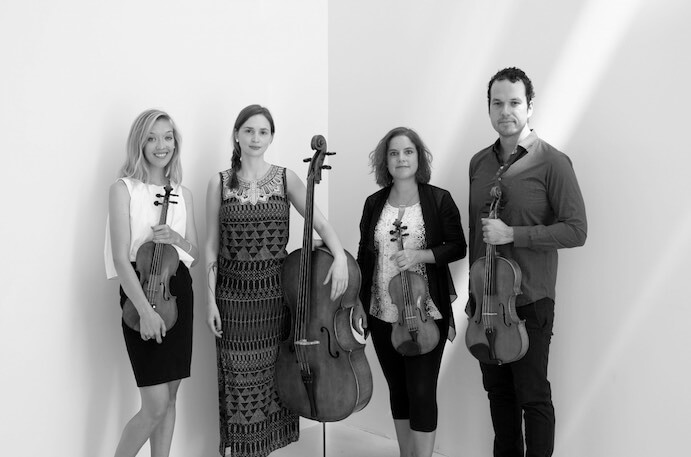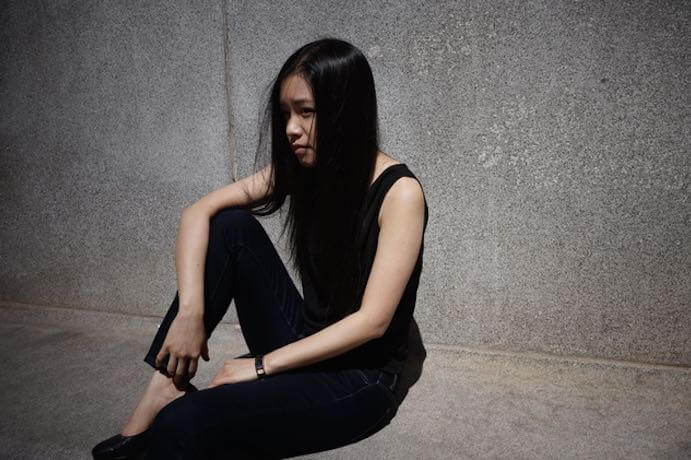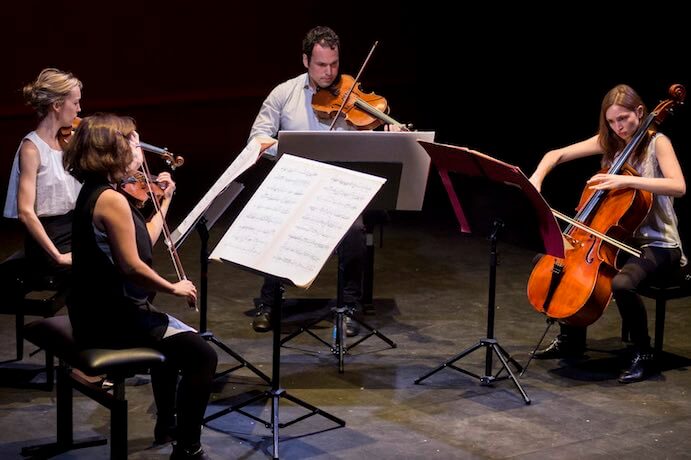From the wine reception at the beginning of the March 23rd ICEBERG New Music concert at Tenri Cultural Institute, to founder Alex Burtzos’ incredibly charismatic MC-ing of the concert, this offering gave a delightful merging of new string quartet music by the enthusiastic and expert talents in the Mivos Quartet. With work by Will Healy, Drake Anderson, Peter Knell, Yu-Chun Chien, Jonathan Russ, and Harry Stafylakis, the standing-room only crowd was was wowed a wide kaleidoscope of musical language and string quartet soundscapes.
Will Healy’s Future Caprices begged the question, “What is the future of classical music? What do we love enough now that we’ll carry it and still have it with us in music in the future?” A brief chat with Healy after the concert expanded on the scope of this idea as presented in his music: Future Caprices is a musical art gallery of the fragments Healy loves enough to bring to the future with him. The result is a beautiful and terrifying collage of string quartet textures – some harkening to music you’ve known for decades, other moments hinted at a future classic; music that knows it WILL be known, someday.

Mivos Quartet
Drake Anderson’s Resonance instead looked towards the past, feeling like echoes of Beethoven slowed down and suspended in sonic animation. Indeed, this work asks performers to “improvise on moments from Beethoven’s first string quartet, Op. 18 No. 1.” The effect of second violinist Lauren Cauley Kalal playing hidden from view on a balcony above the audience brought into lush focus the mournful, wayward feel of this haunting series of resonances.
ICEBERG New Music hosts an annual call-for-scores, and the winner this season was Peter Knell’s Intimate Voices. This piece is tender and delicate, consisting of long, watercolor chords with mere hints of dissonance. The difficult double-stops were well executed by the quartet, though I wish Knell had asked for the glissandi to be emphasized–they were ripe for exaggeration. Built on the G-C-F#-D melodic motive of Janacek’s Intimate Voices, the pulsing climax certainly did remind me of Janacek’s folky, minimal voice.
The following work, Yu-Chun Chien’s Trio for the Mivos Quartet, is a piece that uses structure so persuasively that the musical language could have been anything from Brahms to kazoos: the effect on the audience would be the same, one of convinced awe. Chen employes a myriad of extended techniques, including tapping on the body of the instruments, rattling breathing and energetic, angry mutterings, all of which were effectively carried out by the quartet. This piece of gritty dissonances ended with an astoundingly pleasing tutti music stand smack.

Yu-Chun Chien
Jonathan Russ’ String Quartet 1 (Earth Tones) is made of optimistic, rhythmic sound that exists in stasis and flow. The uplifting nature of this work comes from Russ’ investigation of Schumann resonances, “a series of low-frequency electromagnetic standing waves generated by the Earth’s interaction with the atmosphere.” This work is so calming and hopeful that I could imagine Eckhart Tolle beginning his mornings listening to this work over a cup of tea and a bible passage. Next time, I’d love to hear this work in a church where its resonances could have a bit longer life for my ears before fading out into the air.
The work of Harry Stafylakis is an amalgamation of the classical music tradition and the soul and grime of heavy metal. Inspired by the events of 9/11 and the stories of those involved that have since come to the forefront of the public mind, Stafylakis’ Aftermath is one of those string quartets that really can’t be forgotten because of how effective the opening measures are. Shocking and unnerving, the work begins with eight jarring notes that lead into a series of beautiful chords whose overtones we could actually hear. Just as the chords transformed into their most haunting and desolate, those eight angry notes came in again, jolting. The second movement had just a taste of gypsy-esque string writing, and contained a soulfully-played viola solo— played by Victor Lowrie Tafoya— of which Shostakovich would have been proud. The ballad-like third movement forged a moving final chapter to this work out of glissandi and 16th notes all over plodding, doom-foreshadowing cello pizzicato.
ICEBERG New Music programs two concerts a year, each concert featuring five of the ten composers in the collective plus a guest composer. Picked specifically for their differences, ICEBERG’s roster of decidedly dissimilar composers is one of its greatest strengths: not only does Burtzos lead the audience through the concert with charm, irony, and insight, but I went home after the concert feeling happy and intellectually sated. After all, I’d just experienced a wholesome meal with all of the musical food groups.




















